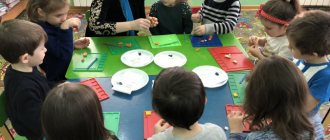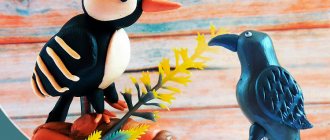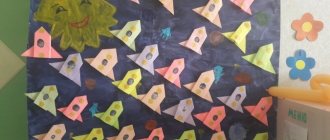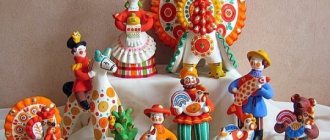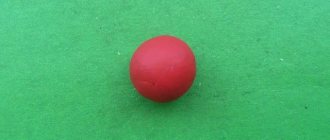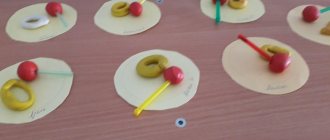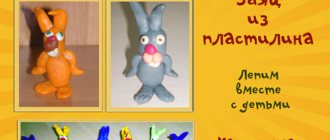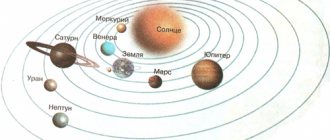Space. Modeling classes, plasticine - Photo report on plasticine "Rocket flies into space"
Publication “Photo report on plasticineography “The rocket is flying in...” Photo report in the middle group “Plasticineography “The rocket is flying into space” The technique of plasticineography is available to children from early preschool age. It allows you to quickly achieve the desired result and introduces a certain novelty into children’s creativity, making it more exciting...
Image library "MAAM-pictures"
Integration of OO: “Social and communicative development”, “Cognitive development”, “Speech development”, “Artistic and aesthetic development”. Objectives: - expand children’s understanding of the world around them (space); - to make children want to create the image of a rocket using technology...
Team work, bas-relief modeling “My Space” Senior group. Photo report Goal: creating a collective panel on the topic “My Space”. Objectives: to improve children’s ability to convey images in sculpting, to develop technical skills and skills in working with plasticine; introduce...
Plasticineography lesson in the senior group on the topic “Space” Goal: increasing interest and expanding children’s ideas about space Tasks: - Continue to introduce children to the technique of plasticineography; — To develop the ability to use a variety of techniques (patching, pulling,...
Space. Modeling classes, plasticine - Abstract of GCD for modeling on the theme "Space"
Goal: To create conditions for making a painting from plasticine on the theme “Space” Objectives: - To form an idea of the planets of the solar system. — Stimulate the development of speech, memory, thinking, develop imagination, fantasy. — Activate children’s vocabulary: space,...
Dear Colleagues! I would like to share the work of joint creativity with children of the middle group. Space is always something unusual, mysterious, alluring, exciting. This is one of those topics that simply captivates children, and then for a very long time they “fly into space”...
We make at once, from one piece of plasticine, both the torso and legs of the astronaut. To do this, roll a cylinder out of plasticine and cut it with a stack approximately to the middle, forming legs.
We make a head in a pressure helmet. Roll a large ball of the same color as the spacesuit, then a small pink ball. We flatten the pink ball into a flat cake and stick it on a large one. It turns out to be the face of an astronaut. We immediately make a face - eyes, nose and mouth from small plasticine balls. Instead of balls, you can use small beads or seed beads. The use of beads is especially important for children who still find it difficult to sculpt small details. We connect the head and torso.
We roll two identical cones or cylinders and apply these handles to the astronaut’s body.
In general, the plasticine astronaut is ready. For kids this is quite enough. Next we make decorations.
Roll five small balls. We will stick four of them to the ends of the arms and legs, and the fifth to the head. Insert an antenna made from a cocktail stick or toothpick and decorate it with a small ball.
What else can be done? Let's decorate and highlight our astronaut's pressure helmet made of plasticine. Roll the sausage and stick it around the face. You can apply the relief using a stamp - a pen rod or the end of a cocktail stick.
Do you want anything else? Please. Make two sausage flagella and stick them crosswise on the torso of our astronaut. Make two cylinders and stick them on the astronaut’s back - these are oxygen cylinders
A plasticine astronaut is ready for intergalactic launches! Make a spaceship for him - .
On the topic: methodological developments, presentations and notes
[] Purpose: To form an emotional response to a work of art “poster”. To develop the ability to create posters - and...
The use of non-traditional drawing techniques to develop fine motor skills of the fingers in children with general speech underdevelopment...
Summary of direct educational activities in the educational field “Artistic and Aesthetic Development” in the 2nd junior group “Snowman”. (using an unconventional drawing technique - the poking method)
With the help of this summary, you can introduce children to an unconventional drawing technique - the poking method. Dry brush painting...
Summary of direct educational activities in the educational field “Artistic and Aesthetic Development” (Musical Activities) in the vocal circle “Merry Notes” (general developmental group for children 5-7 years old)
“Give children more and more general, human, world content, but mainly try to introduce them to this through native and national phenomena.” V. G. Belinsky Nowadays it is very relevant about...
Summary of direct educational activities in the educational field: “Artistic and aesthetic development” with children of the graduating group with intellectual disabilities Type: productive activity (drawing) topic: “Bear in the forest”
Program content: continue to develop a positive attitude towards drawing in children. Teach children to paint over an image of an animal (bear) along the contour using the “poke” method (an unconventional technique...
Summary of direct educational activities in the educational field “Artistic and Aesthetic Development”. Artistic work “Christmas tree decorations”
Synopsis of educational activities in the educational field “Artistic and Aesthetic Development”. Artistic work “Christmas tree decorations”…
Showing publications 1-10 of 137. All sections | Space. Modeling classes, plasticine
They say long ago from outer space
, They say that it is not the first day that a signal reaches the Earth From
space people
! If suddenly a star, like from an apple tree, falls into your palms, It means that their spaceship is flying there along the starry rainbow! I would like to present to your attention a photo report on artistic activities...
In addition to people, other creatures live in our galaxy. Several decades ago, humanity denied the existence of UFOs and extraterrestrial civilizations. However, over the past 10 years, organizations have been created around the world that are now studying the life and varieties of aliens...
Crafts for Cosmonautics Day in kindergarten from plasticine
It has long been proven that manual exercises are very useful for children, especially before school age. Fine motor skills of the hands perfectly develop both hemispheres of the brain. Which subsequently affects both learning and memorization of acquired, new knowledge. What else can you do to keep your child busy, if not making crafts from plasticine?
So, on the eve of such a holiday as Cosmonautics Day, I propose to hold a unique exhibition of children's crafts dedicated to space, stars, astronauts and various planets. At the same time, telling how our universe works, which planet is a satellite of the earth. That in exactly one year our planet makes a complete revolution around the sun. By the way, even the sun is the same star as many other planets without extreme space.
And then the guys can come up with their own composition and mold it from plasticine.
You will find even more crafts here Cosmonautics Day crafts from paper and cardboard with templates or DIY Cosmonautics Day crafts for kindergarten + master class.
The first series of crafts will be dedicated to the beautiful view of outer space:
By clearly showing your child the planets and telling them about the unique features of each, you will not only prepare a beautiful craft, but also learn the structure of our solar system.
What you will need for this:
- Colored cardboard - one sheet of black;
- Plasticine - one pack.
Let's get started:
First of all, mix yellow, red and orange colors to apply the flame of the sun.
The first planet of our solar system is Mercury. It is practically not replete with different colors, so a mixture of white and black plasticine will be enough. Using a needle we pierce several holes. We attach it next to the sun.
The second is Venus. It is larger than the previous specimen, and the color still has brown streaks.
Our globe is attached next. For it we use blue color with green continents.
The moon is attached next to the earth; it is a satellite of our planet.
Mars is coming next. It is more fiery, the colors used are the same as in the sun: red, orange and yellow.
Then Saturn. There is an orange, white and brown tint. More striped, like a tiger cub.
Jupiter is done in a similar way, but multi-colored rings from blocks of ice and boulders are added.
Uranus is not as large as the previous two planets, but the coloring is substantially done. It is prepared from blue and purple shades.
Neptune is blue in color and the same size as Uranus.
The planets can be arranged similarly to the placement in outer space, or, on the contrary, they can be arranged in a single row of planets.
In the craft below, the planets are presented along with meteorites and satellites.
A flying astronaut admiring the beautiful view of his home planet.
Beautiful view of starry space.
The solar system is also presented, which is also labeled for ease of understanding.
Conquest of space by the creation of human hands.
Mastering new achievements.
For a more realistic preparation of the picture, use any cereals as decoration.
Just picture the planets in vacuum.
Plasticine Belka and Strelka are rushing to conquer the moon.
Mini space on skewers, a great option for a preschool exhibition.
Look how limitless a painting made using this technique looks.
And another version of our most beautiful solar system.
Next we’ll talk a little about a man in space, or in other words, an astronaut. It can be depicted using completely different techniques, voluminous or flat, large or small. It depends only on your desire.
Master class on sculpting an astronaut
It’s not at all difficult to prepare, especially for children’s hands. Therefore, I advise you to create such a cosmic miracle.
All you need is plasticine of different colors.
Material is taken in four colors:
- Blue,
- White,
- Red,
- Yellow.
Each is divided into pieces from which we roll into balls. White will be needed for the face, arms and legs. We put our feet in the form of boots.
Blue-red cakes are placed on them one after another. We sculpt the tummy, palms and parts of the face. Let's put it all together. If desired, blind the eyes, mouth and nose. Now the astronaut is ready!
Here is a rocket flight in space with a meeting of unknown creatures.
But our famous friend personally conquers airless space.
And here’s how in the future it will be possible for every inhabitant of the earth to travel to the moon.
Many spaceships gathered to chat.
A beautiful picture of travel between planets.
Our guys never get tired of walking around space.
I would also like to fantasize a little on the topic of aliens. No one has seen them live, but it’s so interesting to come up with their appearance, habits, and flying units. And every time a new copy comes out. Sometimes with one eye, sometimes with eyes and ears, sometimes with one leg, sometimes without a skeleton at all.
You will need:
- Plasticine - packaging in different colors;
- Plastic plates - a couple;
- Float - one;
- Plastic boxes for chocolate eggs - two pieces;
- Blue cardboard - one sheet;
- Candy lid – one piece.
Let's get started:
First, we make aliens out of plastic boxes. You can create completely different ones. For example, I completely covered one with plasticine and sculpted one eye. From the second I made an interesting yellow man. We will fasten the plates to each other.
We attach one alien inhabitant to the top of the improvised flying saucer. Cut a hole in the plastic lid. Glue it on top, above the alien.
Glue white stars on blue cardboard made of white plasticine. At one end we install a flying saucer, at the other end we attach a man.
That's all, you can decorate the flying unit at your discretion by adding silver stars or symbols.
Just as unusual alien inhabitants look absolutely extraordinary, their ships can be of completely different shapes and sizes, with or without legs, round or oblong in appearance. Let the child build his own invention.
But here is an interesting picture depicting both astronauts and inhabitants of other planets.
Look how scary it is, but in fact this is a very kind humanoid. And he smiles broadly at you.
What would I say about these creatures? They are intimidating and formidable. Capable of conquering any planet. It's good that they are made only from plasticine. But by giving them a plasticine smile, you can radically change their mood and turn them into the kindest alien creatures.
Look at the variety of humanoids a child is quite capable of creating on his own. Sometimes their imagination is an order of magnitude broader and more interesting than the fictional world of an adult.
And if, in addition, you take dry plant preparations or straws for juice, then you can make even more unearthly creatures.
And let them wander across the surface of your table, looking at each other in surprise.
And if it’s not on your table, but on a plasticine picture, that’s even better. There are even more design options for your imagination.
Plasticine paintings attract with their originality and volume.
But they playfully stick out their tongue, as if saying, let's play, buddy!
This is not all that could be described and shown to you, but I think this is not necessary. Call your child and together you come up with ideas for crafts and plasticine paintings. This is not only your communication, but also incredibly powerful development of the child’s brain. Which will definitely have a beneficial effect on development and learning in later life. But the most important meaning in life for most parents is to give a powerful impetus to the life and maximum development of the child. And it is joint creativity that perfectly fulfills this function.
MAGAZINE Preschooler.RF
Summary of a lesson in artistic modeling on the topic: “Space travel”Additional education teacher Dyakova M.A. MAU DO "House of Children's Creativity" Pechora 2016 - 2017
Goal: Formation of the foundations of patriotic education.
Tasks:
Educational:
- Gaining insight into the structure of the spacesuit
- Gaining experience in costume modeling
Educational:
- Development of cognitive interest in Cosmonautics Day and space exploration.
- Ability to plan your activities
- Development of creative self-expression, independence and imagination.
Educational:
1. Formation of patriotism, a sense of pride for the Motherland.
Type of lesson:
Thematic, complex (cognitive and developmental activities; artistic and aesthetic).
Lesson form:
Group, individual.
Forms and methods of work:
- Visual: presentation.
- Practical: modeling method.
- Verbal: conversation.
- Partial search: independent work.
Teaching methods:
- visual (auditory and visual) - viewing the presentation
- verbal - conversation
- informative
- problematic - exploratory - understanding the artistic image and searching for techniques and methods of execution
Progress of the lesson:
1. Organizational:
— Do you know what holiday we celebrate on April 12? (children's answers).
— That's right, Cosmonautics Day or International Day of Human Space Flight.
On this day in 1961, the planet's first cosmonaut launched on board the Vostok 1 spacecraft. Who is he? (Children's answers) Yuri Alekseevich Gagarin.
2. Main stage:
— And now I suggest you watch the presentation about this flight.
View the presentation (slides 1-9).
— Guys, what qualities do you think Yuri Gagarin had? (courage, determination, endurance, etc.)
Guys, have you guessed what the topic of our lesson is? (answer options: space, astronauts, space flight, etc.) The topic of our lesson is “Space travel” . Do you want to go on a space journey? I will be the captain of our ship, and you will be the astronauts. And we'll go on a rocket! (ready rocket). We have a rocket, are we in the mood to win? Eat! But something is still missing. What? (leading questions; children’s answers: special clothes, astronaut suit). That's right, spacesuits!
Let's see what a spacesuit is and what it is needed for.
View the presentation. (10-18 slides)
3. Verification stage:
- So why do astronauts need a spacesuit? (For protection from an aggressive external environment; creating an environment similar to that of Earth; heating; providing oxygen; protection from meteorites).
— What color was the space suit of the first cosmonaut, Yuri Gagarin? (Orange)
- Guys, do you remember what parts the spacesuit consists of? Name them. (Helmet, gloves, soft parts, pipeline, safety rope, control panel and others).
-Well done boys! You watched and listened carefully and learned a lot about spacesuits!
Now you know what they are and why astronauts need them.
I initiate you into level 1 astronauts and solemnly present you with an image of a spacesuit, but in order to go on a space journey, we need to finalize our suit. Our spacesuits may vary in color and suit details. But remember the qualities of astronauts, they will help us in our work: independence, resourcefulness, the ability to finish a job, accuracy and precision.
Do you think you have these qualities? Then get to work! In 15 minutes our spaceship sets off on its journey!
4. Practical part of the lesson: (explanation of the task).
— To build yourself a spacesuit, take the blanks, evenly distribute the plasticine over them, add any parts necessary for the astronaut, which can be made from flagella strips, balls, you can use rolling and chopping techniques. Then glue your photo to the helmet and stick a plasticine roller around it. Glue the porthole on top of the roller.
After 15 minutes:
-Guys, who is ready to have their spacesuit checked by the ship's captain?
I see everyone is ready to conquer the vastness of space!!!!
Take your seats and fasten your seat belts!
5,4, 3, 2, 1, Start!
(video of the ship launch, views of the Earth from space accompanied by “cosmic” music, slide 20)
And here we are in space! It's time to leave your mark! Take your image and attach it to a planet or rocket. And this planet is the planet of your mood! If you are in a good mood, take a yellow flag and attach it to the Mood planet, if you are in a normal mood, take a red flag, and if you are in a bad mood, take a blue flag.
Reflection:
Now sit down in your seats and please rate whether it was difficult or not for you in the lesson. Select and paint 1 section of the circle.
flags made of toothpicks and self-adhesive boom, a cup with markers, plates with faces (sad and happy) in which to put flags, a background - space, a rocket, portholes - from bottles, blanks, print out photos of children and cut them out, glue stick, presentations, projector, color. Pencils, music)
| Next > |
Sculpting lesson notes. Space
Belkova Elena Sergeevna
Abstract of the OOD in the Preparatory Group for Modeling: “How amazing the world of space is”
Goal: Expand children's understanding of space. Objectives: - to teach how to independently create various images - to instill in children interest and respect for the profession of astronaut, a sense of pride for the fact that the first Russian man in space was - to develop fine motor skills in children Preliminary work: Examination of illustrations, reading an encyclopedia about space, conversation about the first man to go into outer space; learning rhymes about space, guessing riddles about space. Reading of the work “Young Stargazers” by T. Heine, V. Tavares. Material: A5 sheets of cardboard, individually packaged plasticine, stacks, modeling board, napkins, space illustrations on an A4 sheet on a board, portrait of Yu. Gagarin.
Progress of work Children sit in a semicircle on the carpet Q: - Guys, do you like to travel? Me too. And today I invite you to go on a distant space journey to unknown planets. But first, guess the riddle: A girl from St. Petersburg was walking, spilling a jug of beads. Neither the king, nor the queen, nor the beautiful maiden will gather. (Stars in the sky) Q: -On a cloudless, clear evening, the sky above our head is strewn with thousands of stars. They seem to us like small sparkling dots because they are far from the Earth. In fact, the stars are very big. And many have their own names: for example, the North Star. The big stars are connected into constellations, which also have their own names: Ursa Major and Ursa Minor, Aries, Taurus, Cancer, Leo and others. (children look at and find familiar constellations on the star map) - Look at our starry sky. What do you see there? (comets, stars, asteroids, the sun, space stations, planets, but not all). How many planets do you know? (9 look at them on the map)
There is no air in space. And nine different planets are circling there, And the sun is a star in the very center of the system and we are all connected by gravity.
Q: - Guys, name the planets that revolve around the sun. Listen to how our poets described all nine planets: In order, all the planets can be named by any of us: One - Mercury, Two - Venus, Three - Earth, Four - Mars, Five - Jupiter, Six - Saturn, Seven - Uranus, Behind it - Neptune, He is the eighth in a row. And behind it, then, is the ninth planet called Pluto. Q: - Guys, look at our planet Earth, how beautiful it is from space and how small it is compared to other planets (on the screen is planet Earth - view from space). The sun is a huge star. But there are stars much larger than our sun. Now look again at our star map and tell me which planets are missing there? (Venus, Earth, Saturn, Uranus, Neptune). Let's guys remember what color they are? Right! Well done! You know the planets well! I suggest you draw the missing planets, but you will draw them in an unusual way - with plasticine. Want to? But first we need to warm up.
Physical education lesson We quickly got into the rockets (children perform hand movements, imitating running in place) We flew into space together. (children raise their arms above their heads and join their palms, forming a cone above their heads) There are a lot of beauties around! (children spread their arms to the sides) The earth in the distance has become like a dot. (children connect the index and thumb of each hand, and then join their hands together. The connection of four fingers (the index and thumbs of the left and right hands shows how small the planet seems) We went out into space - weightless, Everything is not at all like at home! ( While these two lines are being heard, children perform slow voluntary movements, imitating movement in weightlessness) Let's return quickly (children perform a circular movement towards themselves with their left and right hands) So that we don't get bored without friends! (children raise their index finger)
Take a seat at the tables. Guys, remember what color the sky is in space? Children's answers. V.- That’s right, the color of the sky in space can be blue, black, purple, lilac. Well, I suggest we start sculpting planets, let's get creative. While the children are working, the teacher helps them with advice. Q: — You did a wonderful job. Well, now our star map is complete, the planets have taken their places. Guys, listen to the poem “Solar System”, written by the poet Vasily Bely: The first to meet solar storms is the elusive, little Mercury. Venus flies second behind him, With a heavy, dense atmosphere. And the third is the carousel, our earthly cradle. The fourth is Mars, the rusty planet, the red-orange one. And then they rush by like a swarm of bees, Asteroids in their orbit. The fifth is Jupiter, very large and clearly visible in the starry sky. sixth - Saturn, in chic rings, Charming, under the rays of the sun. The seventh - Uranus, lay down like a couch potato, After all, his long path is difficult. The eighth is Neptune, the fourth gas giant. He is a dandy in a beautiful blue shirt. Pluto, Charon, the ninth in the system, pass the time in the darkness as a duet. Analysis of works Exhibition of works

